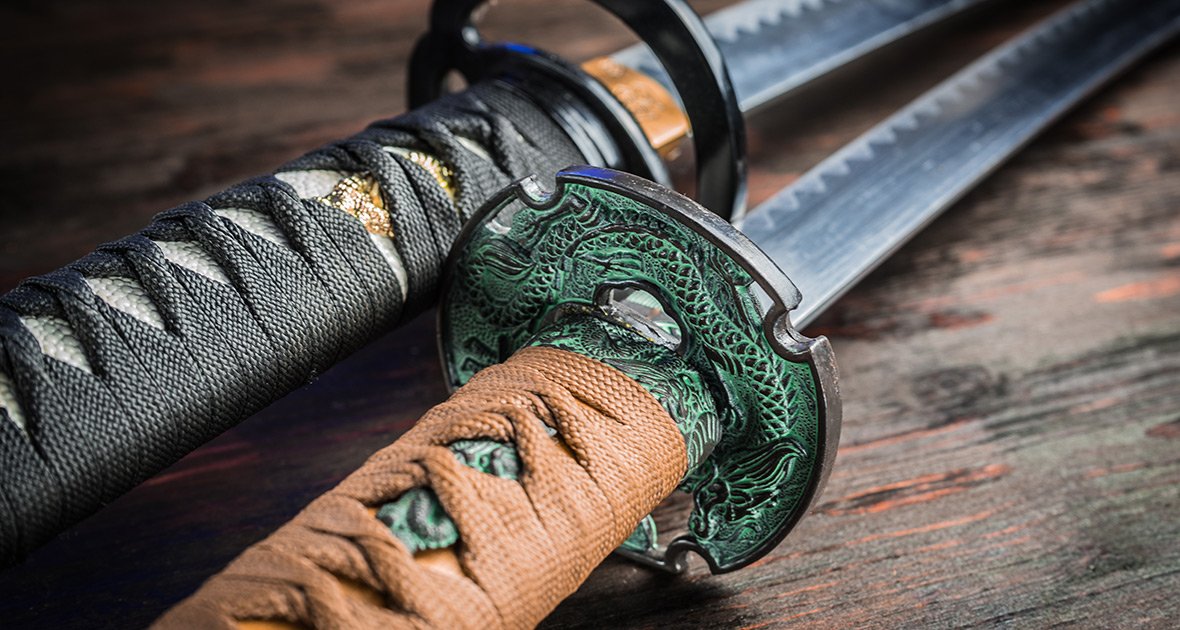The katana sword, a sleek and powerful symbol of Japanese culture, has long captivated the imaginations of people around the world. This curved, single-edged sword is not only a tool of war but also a deeply entrenched part of Japan’s artistic and martial heritage. For centuries, the katana was synonymous with the samurai—Japan’s warrior class—and its design and crafting techniques were perfected to reflect their ideals of honor, discipline, and strength. Today, the katana is revered as a masterpiece of craftsmanship, an enduring cultural icon, and a symbol of timeless values.
This article explores the rich heritage of the katana sword, the intricate craftsmanship behind its creation, and how it continues to hold relevance in modern times, both as a cultural symbol and as a tool for martial practice.
The Historical Legacy of the Katana
The katana sword’s origins can be traced back to Japan’s feudal period, particularly the Kamakura era (1185–1333), when the samurai class began to rise in prominence. Unlike the straight-edged swords of earlier periods, the katana’s distinct curved shape, single-edged blade, and longer grip were developed to accommodate the specific needs of mounted samurai warriors. Its design was optimized for cutting in fast, fluid motions, which made it incredibly effective in close-quarter combat.
By the 14th century, the katana sword had fully evolved into the weapon of choice for samurai. It was more than just a tool of war—it was a reflection of a samurai’s identity, code of conduct, and values. The bushido code, which governed the life and actions of samurai, emphasized loyalty, honor, and self-discipline. The katana, as an extension of the samurai’s spirit, was treated with great respect and carefully maintained as a symbol of their soul.
Throughout Japan’s history, the katana sword was regarded as a powerful weapon, capable of delivering swift, decisive cuts. In battle, its effectiveness was enhanced by its craftsmanship and design, which allowed for both precision and speed. The katana became a powerful emblem of the samurai ethos, representing a warrior’s dedication to perfection, mastery, and the pursuit of honor.
Masterful Craftsmanship: The Art of Forging a Katana
Creating a katana sword is an extraordinarily intricate and time-consuming process that requires skill, patience, and generations of knowledge. Traditional katana forging follows a highly refined set of techniques, passed down through centuries of craftsmanship. Each katana is forged to achieve a balance of strength, flexibility, and cutting ability, making it not just a weapon, but a work of art.
1. Forging the Steel
The katana sword is traditionally crafted using tamahagane, a high-quality steel produced through the smelting of iron sand. The process of creating this steel is known as tatara, and it requires great expertise. The smelting furnace used in tatara is specially designed to produce steel with the right composition of carbon and iron. The resulting material is then used to form the blade.
One of the key aspects of katana forging is the folding process, where the steel is repeatedly folded and hammered to remove impurities and evenly distribute carbon. This not only strengthens the blade but also results in the layered pattern that is visible on many katana blades, known as hada. The folding process contributes to the katana’s legendary durability, ensuring it is both hard enough to cut through armor and flexible enough to absorb the shock of impact.
2. Shaping the Blade
After the steel is properly prepared, the swordsmith begins to shape the katana sword. Unlike most Western swords, the katana has a distinctive curve that enhances its cutting ability. This curvature is formed through the use of heat and controlled cooling, creating a blade that is both resilient and sharp. The curvature allows the katana to deliver rapid, efficient cuts, particularly when drawn from its scabbard.
Once the basic shape is achieved, the katana sword is hardened through a process called yaki-ire, where the blade is coated in clay and heated to extremely high temperatures before being quenched in water. This creates the characteristic hamon (temper line) along the edge of the blade, which varies in shape and appearance depending on the swordsmith’s techniques. The hamon not only serves an aesthetic purpose but also indicates the differential hardening that makes the katana both sharp and flexible.
3. Polishing and Finishing
Polishing a katana sword is one of the most critical stages in the process and is performed by specialized craftsmen known as togishi. Polishing is done using a series of progressively finer polishing stones, a process that can take days or even weeks to complete. The goal of polishing is not only to sharpen the blade but to bring out its beauty, revealing the intricate patterns of the steel, including the hamon and hada.
The finishing touches of the katana sword include the crafting of the hilt (tsuka), hand guard (tsuba), and scabbard (saya). The tsuka is often wrapped in silk or leather cord over a layer of ray skin for a secure grip. The tsuba can be decorated with intricate designs that reflect the sword’s history, purpose, or the owner’s personality. The saya (scabbard) is often lacquered to enhance the blade’s protection and appearance, completing the katana’s overall elegance.
The Katana sword in the Modern World
Though the katana is no longer used in battle, it retains profound cultural significance and continues to captivate people worldwide. Today, the katana exists not only as a historical artifact but also as a symbol of traditional values, an object of martial discipline, and a cultural icon in art and media.
1. Symbol of Tradition and Heritage
In Japan, the katana sword remains a symbol of the samurai’s code of honor, bushido, and the cultural values it represents. It is not uncommon for the katana to be displayed in traditional settings, such as in temples, shrines, or homes, where it is viewed as a reminder of the past and a token of respect. The katana also continues to be used in various ceremonial contexts, including weddings, graduations, and other rites of passage, where it symbolizes the ideals of strength, protection, and integrity.
For those outside Japan, the katana sword represents a connection to Japanese history and craftsmanship. Museums worldwide house extensive collections of katana swords, allowing people to learn about Japan’s rich tradition of sword-making. The katana, as a highly prized and historically significant artifact, remains a revered object of fascination.
2. Martial Arts Practice and Modern Usage
The katana sword continues to play a vital role in Japanese martial arts, particularly in disciplines like kenjutsu, iaido, and kendo.
Kenjutsu is the traditional art of sword fighting, where practitioners learn techniques for wielding the katana in combat situations. While it is no longer used in actual battle, kenjutsu remains an important part of martial arts culture and is practiced by those seeking to preserve traditional swordsmanship.
Iaido focuses on the art of drawing and cutting with the katana, where practitioners learn the technique of unsheathing the sword and executing a swift cut in a single motion. This form is often practiced in a more meditative and ritualistic manner, with an emphasis on precision and control.
Kendo, a modernized form of sword fighting, uses bamboo swords and protective gear but is deeply rooted in the values of katana-based martial arts. Kendo emphasizes speed, focus, and discipline, all of which were integral to the use of the katana in battle.
These martial arts not only preserve the technical aspects of katana swordsmanship but also maintain the deeper values of respect, honor, and self-control that the samurai embodied.
3. Cultural Icon in Media and Entertainment
The katana has become a staple in global popular culture, appearing in everything from films to video games to anime. In Hollywood, the katana is often used to represent the ideals of the warrior class or to add an exotic, dramatic element to characters. Iconic film characters like Kill Bill’s Beatrix Kiddo or The Last Samurai’s Tom Cruise wielding a katana have cemented its place as a symbol of strength and precision in Western entertainment.
In Japanese anime and manga, katana-wielding characters are often portrayed as heroic or honorable, adding to the sword’s mystique. From Rurouni Kenshin to Bleach, the katana is depicted as a symbol of skill, inner conflict, and personal growth.
4. Collector’s Item and Investment
The katana sword is also a highly sought-after collector’s item. Well-preserved katanas from renowned swordsmiths or historical periods can fetch substantial prices at auctions. Collectors prize these swords not only for their functional attributes but for their aesthetic value and the historical stories they carry.
In recent years, the market for high-end, hand-forged katana sword replicas has also grown, with collectors and enthusiasts eager to own a piece of traditional Japanese craftsmanship. Some swordsmiths continue to craft katana blades by hand, maintaining the centuries-old techniques while adding modern touches to meet contemporary standards.
Conclusion:
The Enduring Legacy of the Katana
The katana sword is more than just a weapon—it is a living testament to Japan’s cultural heritage, a reflection of the artistry and precision of its makers, and a symbol of the values of the samurai. Though the katana may no longer be used in battle, it continues to resonate with people around the world, inspiring martial artists, collectors, historians, and those with a deep appreciation for craftsmanship.









